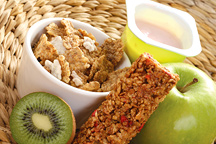Fortunately, these bacteria can be replenished through the diet. Manufacturers of food products and dietary supplements have developed technologies that allow them to add live bacteria to foods and beverages. Most probiotic products on the market contain live cultures of bacteria like Lactobacilli bifidobacteria. Dannon's mega-product Activia contains live cultures of "Bifidus Regularis."
Prebiotics, on the other hand, can simply be described as the food that the bacteria "feed on." This bacterial "feeding" process, of course, is actually fermentation. So far, most of the prebiotics that have been identified are fibers and other nondigestible carbohydrates. When prebiotic fibers are fermented by probiotic bacteria in the colon, the result is the production of carbon dioxide and short-chain fatty acids (SCFAs). There are three types of SCFAs produced: acetate, propionate and butyrate. These short-chain fatty acids are beneficial to digestive and immune health.
Fiber, Fermentation and Digestive Health
It's estimated that up to 70 percent of the immune system is located in the large intestine. This might seem unfathomable, but it's directly related to the fermentation activity of the probiotic bacteria, which ferment prebiotic fiber in the large intestine. The benefits to digestive health of fermentation and SCFA production in the colon are numerous.
Short-chain fatty acids lower the pH of the colon, creating an environment hostile to various pathogens such as clostridia. Populations of pathogenic bacteria are reduced as the population of "good" bacteria increases. The carbon dioxide produced by fermentation also is a substrate for many of the beneficial probiotic bacteria. As their numbers increase, they are able to crowd out the pathogenic bacteria when they compete for binding sites and nutrients in the colon. In fact, researchers have shown that some diarrhea-causing bacteria like E. coli and salmonella are unable to colonize the gut lining in the presence of probiotic bacterial fermentation. This improves immune health.
 Short-chain fatty acids provide energy for the cells that line the surface of the colon, known as colonic epithelial cells or colonocytes. The healthier and more robust these cells are, the better the overall integrity of the colonic wall. A study in the Journal of Surgical Research showed that SCFAs also stimulate protein synthesis in the colonocytes. This enables cell replenishment, building a more resilient colonic cell wall. This then protects the individual from foreign materials (toxigens) that would otherwise penetrate the wall.
Short-chain fatty acids provide energy for the cells that line the surface of the colon, known as colonic epithelial cells or colonocytes. The healthier and more robust these cells are, the better the overall integrity of the colonic wall. A study in the Journal of Surgical Research showed that SCFAs also stimulate protein synthesis in the colonocytes. This enables cell replenishment, building a more resilient colonic cell wall. This then protects the individual from foreign materials (toxigens) that would otherwise penetrate the wall.
Studies in rats have shown that butyrate helps with the muscles of the colon and with intestinal motility. While this has not yet been studied in humans, it likely has a similar effect. Intestinal motility helps with laxation and regularity.
As a secondary benefit, the lower pH of the colon helps to improve the absorption of minerals such as calcium and magnesium. The levels of prebiotic fiber needed to produce this effect differ among the different types of fiber. Some fibers are fermented to a greater extent and therefore produce a more noticeable effect.
Not All Fibers Are Prebiotics
One of the most important aspects of fiber's effect on digestive health is that not every fiber is a probiotic; i.e., not every fiber is fermented by the probiotic bacteria. Colonic bacteria only have the ability to metabolize and digest certain fibers. There are many fibers fermented by bacteria, but several others are not fermented. Soluble fibers (oat beta-glucan, inulin and digestion-resistant dextrins) are prebiotic and are fermented to produce these benefits. On the other hand, fibers such as cellulose and psyllium are not prebiotic and therefore not fermented. In general, the majority of insoluble fibers are not prebiotic. Another important point to note is that the physical structure of the fiber determines how much of it is fermented, and how rapidly it is fermented. Certain fibers with shorter chains and less complex structures are fermented much more quickly, while more complex fibers are fermented more slowly.

